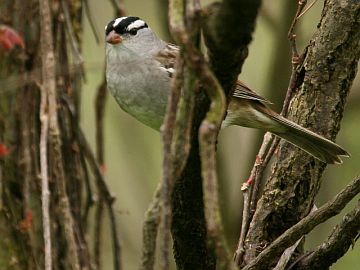8 December 2008
December 2008
Now it’s really winter and the birds who lingered up north are coming here to escape the cold, dark and lack of food. Chuck Tague has published his latest phenology to let you know who these newcomers will be through early January.
Here’s a summary of his list and a few suggestions of my own. Click here for Chuck’s complete list.
- Get close to the moon on December 12th, the closest and largest full moon of 2008. Chuck gives suggestions on where to observe it.
- As the lakes freeze up north check the rivers for newly arrived ducks, geese and gulls. Check the creeks for great-blue herons and belted kingfishers.
- Snow cover forces tundra birds our way. Search manured fields for horned larks, snow buntings and lapland longspurs. Watch for rough-legged hawks hunting over the snow.
- White-crowned sparrows are becoming more common here in winter. I hope I see one of them (pictured above) on the Christmas Bird Count.
- The 109th annual Christmas Bird Count (CBC) will be held across North America from Sunday December 14 through Sunday January 5th. Go to page 7 here to see the list of CBCs with contact information should you wish to participate. I’ll be counting on two of them: Buffalo Creek on December 14 and the Pittsburgh count on December 27.
- Winter begins on December 21, the winter solstice. The days will start getting longer after the solstice but you probably won’t notice for a few weeks.
- After winter’s silence, song sparrows will sing on the first sunny day in January.
What species will be the first bird you see in 2009? It’s something to look forward to!
(photo by Chuck Tague)
I look forward to you posting these summaries. My heart suddenly felt heavy when I was reminded that winter doesn’t even officially start for a couple more weeks. It sure feels like winter right about now.
The song sparrows singing in January more than made up for it though.
In this blog I said I hoped to find a white-crowned sparrow on the Buffalo Creek CBC. Hooray, I did!